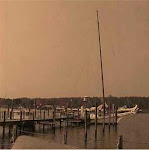 |
| All red markers to port leaving Island Creek. |
 The Dee of St. Mary’s left home today.
The Dee of St. Mary’s left home today.For 30 years her port of call has been Sea-Fruit Oyster House on St. George Island.
This morning she headed out to Calvert Marine Museum on Solomons Island, MD and docked early afternoon at the museum's Lore Oyster House exhibit.
It has taken the past 12 years for the Dee of St. Mary's to
find a safe harbor to see her beyond this generation. A two-year renovation funded by members of the Chesapeake Bay Field Lab and the Maryland Historical Heritage Administration now coupled with an outreach from Calvert Marine Museum still isn’t a guarantee. It is not merely that skipjacks are relics of a bygone era, their supporting industry gone. Public and private funding suggest that historic artifacts
no longer carry the intrinsic cultural value they did even a decade ago. Skipjacks, in a blunt assessment recently put to me, are passé.
Be that as it may, the Calvert Marine Museum remains
committed to preserving the maritime heritage of the Chesapeake Bay. The organization is welcoming the freshly renovated and re-certified Dee of St. Mary's for an
extended visit. In cooperation with the Chesapeake Bay Field Lab, the 501(c)3
that owns the Dee of St. Mary’s, the museum is exploring future opportunities for this youngest member of the last commercial sailing fleet in North America.
Please keep in touch with both organizations ( Calvert Marine Museum, Chesapeake Bay Field Lab ) for ways to
help.





